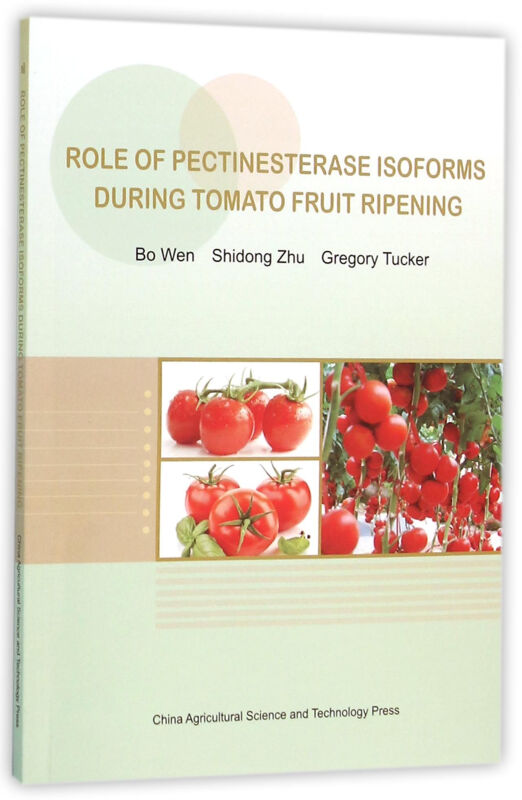暂无评论
图文详情
- ISBN:9787511624116
- 装帧:暂无
- 册数:暂无
- 重量:暂无
- 开本:21cm
- 页数:144
- 出版时间:2016-01-01
- 条形码:9787511624116 ; 978-7-5116-2411-6
本书特色
本书主要介绍作者在英国研究期间从事园艺植物番茄生理生化、遗传育种、果实采后贮藏加工等生物学的研究与实验等方面所取得的新成果,
内容简介
《番茄果实成熟中的果胶甲酯酶(英文版)》主要介绍作者在英国研究期间从事园艺植物番茄生理生化、遗传育种、果实采后贮藏加工等生物学的研究与实验等方面所取得的新成果。
目录
CHAPTER 1 INTRODUCTION
1.1 Fruit
1.1.1 General introduction
1.1.2 Tomato
1.2 Fruit ripening
1.2.1 Colour, flavour and texture changes in fruit ripening
1.2.2 Ethylene in fruit ripening
1.3 Plant cell wall
1.3.1 General introduction
1.3.2 Cell wall components
1.3.3 Cell wall structure
1.4 Cell wall enzymes
1.4.1 Polygalacturonase (PG)
1.4.2 Pectate lyases
1.4.3 β-Galactosidase
1.4.4 Expansin
1.5 Pectinmethylesterase
1.5.1 PE proteins
1.5.2 PE modes of action and regulation
1.5.3 PE genes and isoforms
1 5.4 Tomato PE antisense lines
CHAPTER 2 MATERIALS AND METHODS
2.1 Plant material
2.1.1 Tomato growth and maintenance
2.1.2 Crossing tomato
2.2 Chemicals
2.3 Fruit texture analysis
2.4 Biochemical methods
2.4.1 Extraction of crude protein from tomato fruits
2.4.2 Bio-Rad (Bradford) protein assay
2.4.3 Pectinesterase assay
2.4.4 Heparin affinity chromatography
2.4.5 PE profile assay
2.4.6 Concentration of pooled PE isoforms
2.4.7 Total leaf protein extraction for SDS PAGE analysis.
2.4.8 Making acetone insoluble solid (AIS)
2.4.9 Determination of degree of esterification (DE) of the pectin by titration
2.4.10 Extraction of CDTA Soluble Pectin
2.4.11 Determination of Neutral Sugars
2.4.12 Determination of uronic acid
2.5 Molecular biological methods
2.5.1 DNA extraction from tomato leaves
2.5.2 DNA measurement
2.5.3 Polymerase chain reaction (PCR)
2.5.4 Restriction enzyme digestion
2.5.5 Agarose gel electrophoresis
2.5.6 DNA sequence (MWG value read)
2.5.7 PCR product purification by Perfectprep Gel Cleanup Kit (Eppendorf):
2.6 Immunochemistry and immunolabelling
2.6.1 Immunodot assay
2.6.2 Immunolocalization
2.7 Statistics
2.8 Capillary Electrophoresis (CE)
2.8.1 Enzyme digests
2.8.2 CE
CHAPTER 3 GENERATION OF DOUBLE ANTISENSE PLANTS
3.1 Plant generation
3.2 Generation of the double antisense plants
3.3 PE Isoform profilers of double antisense plants
3.3.1 PE extraction method optimisation
3.3.2 PE profiles in tomato fruit
3.4 Summary
CHAPTER 4 CHARACTERIZATION OF PE SINGLE AND DOUBLE ANTISENSE PLANTS
4.1 Fruit PE activity,and morphology analysis
4.1.1 Generation of wild-type controls
4.1.2 Fruit PE activities
4.1.3 Fruit morphology and softening
4.2 Cell wall component analysis
4.2.1 UA in acetone insoluble solids (AIS) and CDTA soluble pectin
4.2.2 DE of pectin in AIS
4.2.3 Neutral sugar analysis by GC
4.3 Capillary electrophoresis (CE) of pectin
4.3.1 DE of CDTA soluble pectin
4.3.2 CE profiles of PG digested CDTA soluble pectin
4.4 Characterization of antisense lines using monodonal antibodies
4.4.1 Immuno-dot blot analysis of CDTA soluble pectin
4.4.2 Immunolocalization: Fruit pericarp
4.4.3 Immunolocalization: Stem
4.5 Summary
4.5.1 Biochemical and morphological study
4.5.2 Immunological study
CHAPTER 5 USE OF ANTISENSE LINES FOR PE ISOFORMS ANALYSIS
5.1 Introduction
5.2 Effect of pH on PE activity
5.3 PE isoform profiling
5.3.1 Fruit
5.3.2 Stem
5.3.3 Leaf
5.4 Summary
CHAPTER 6 OVERALL DISCUSSION
6.1 Role of PE during fruit ripening
6.2 PE isoforms in vegetative tissues
6.3 Unstable PE1 expression in double antisense lines.
6.4 Future work
REFERENCES
1.1 Fruit
1.1.1 General introduction
1.1.2 Tomato
1.2 Fruit ripening
1.2.1 Colour, flavour and texture changes in fruit ripening
1.2.2 Ethylene in fruit ripening
1.3 Plant cell wall
1.3.1 General introduction
1.3.2 Cell wall components
1.3.3 Cell wall structure
1.4 Cell wall enzymes
1.4.1 Polygalacturonase (PG)
1.4.2 Pectate lyases
1.4.3 β-Galactosidase
1.4.4 Expansin
1.5 Pectinmethylesterase
1.5.1 PE proteins
1.5.2 PE modes of action and regulation
1.5.3 PE genes and isoforms
1 5.4 Tomato PE antisense lines
CHAPTER 2 MATERIALS AND METHODS
2.1 Plant material
2.1.1 Tomato growth and maintenance
2.1.2 Crossing tomato
2.2 Chemicals
2.3 Fruit texture analysis
2.4 Biochemical methods
2.4.1 Extraction of crude protein from tomato fruits
2.4.2 Bio-Rad (Bradford) protein assay
2.4.3 Pectinesterase assay
2.4.4 Heparin affinity chromatography
2.4.5 PE profile assay
2.4.6 Concentration of pooled PE isoforms
2.4.7 Total leaf protein extraction for SDS PAGE analysis.
2.4.8 Making acetone insoluble solid (AIS)
2.4.9 Determination of degree of esterification (DE) of the pectin by titration
2.4.10 Extraction of CDTA Soluble Pectin
2.4.11 Determination of Neutral Sugars
2.4.12 Determination of uronic acid
2.5 Molecular biological methods
2.5.1 DNA extraction from tomato leaves
2.5.2 DNA measurement
2.5.3 Polymerase chain reaction (PCR)
2.5.4 Restriction enzyme digestion
2.5.5 Agarose gel electrophoresis
2.5.6 DNA sequence (MWG value read)
2.5.7 PCR product purification by Perfectprep Gel Cleanup Kit (Eppendorf):
2.6 Immunochemistry and immunolabelling
2.6.1 Immunodot assay
2.6.2 Immunolocalization
2.7 Statistics
2.8 Capillary Electrophoresis (CE)
2.8.1 Enzyme digests
2.8.2 CE
CHAPTER 3 GENERATION OF DOUBLE ANTISENSE PLANTS
3.1 Plant generation
3.2 Generation of the double antisense plants
3.3 PE Isoform profilers of double antisense plants
3.3.1 PE extraction method optimisation
3.3.2 PE profiles in tomato fruit
3.4 Summary
CHAPTER 4 CHARACTERIZATION OF PE SINGLE AND DOUBLE ANTISENSE PLANTS
4.1 Fruit PE activity,and morphology analysis
4.1.1 Generation of wild-type controls
4.1.2 Fruit PE activities
4.1.3 Fruit morphology and softening
4.2 Cell wall component analysis
4.2.1 UA in acetone insoluble solids (AIS) and CDTA soluble pectin
4.2.2 DE of pectin in AIS
4.2.3 Neutral sugar analysis by GC
4.3 Capillary electrophoresis (CE) of pectin
4.3.1 DE of CDTA soluble pectin
4.3.2 CE profiles of PG digested CDTA soluble pectin
4.4 Characterization of antisense lines using monodonal antibodies
4.4.1 Immuno-dot blot analysis of CDTA soluble pectin
4.4.2 Immunolocalization: Fruit pericarp
4.4.3 Immunolocalization: Stem
4.5 Summary
4.5.1 Biochemical and morphological study
4.5.2 Immunological study
CHAPTER 5 USE OF ANTISENSE LINES FOR PE ISOFORMS ANALYSIS
5.1 Introduction
5.2 Effect of pH on PE activity
5.3 PE isoform profiling
5.3.1 Fruit
5.3.2 Stem
5.3.3 Leaf
5.4 Summary
CHAPTER 6 OVERALL DISCUSSION
6.1 Role of PE during fruit ripening
6.2 PE isoforms in vegetative tissues
6.3 Unstable PE1 expression in double antisense lines.
6.4 Future work
REFERENCES
展开全部
作者简介
温波博士:安徽农业大学园艺学院副教授,硕士生导师,2003年5月至2004年5月在英国诺丁汉大学植物科学系做访问研究;2005至2009年在英国诺丁汉大学生物科学学院攻读博士;2009至2012年在卡迪夫大学从事博士后研究;2013年至今在安徽农业大学园艺学院工作。
本类五星书
本类畅销
-

常见树木图鉴
¥14.0¥48.0 -

流行草花图鉴
¥4.8¥13.0 -

清代雍正时期的京畿水利营田
¥11.9¥32.0 -

中国传统民俗文化:科技系列:中国古代农具
¥18.4¥58.0 -

花史左编
¥22.8¥68.0 -

齐民要术之语言特色研究
¥10.1¥26.0 -

中国古代农业
¥9.0¥25.0 -

南方菜园月月农事巧安排
¥3.7¥10.0 -

中国粮食经济史(国家出版基金)
¥42.2¥75.0 -

城眼观乡:农业中国的农村怎样成了国家问题(1908—1937)
¥64.4¥88.0 -

20世纪80年代以来中国女性主义文学批评研究
¥15.4¥45.0 -

20世纪中国科学口述史:农业科技“黄淮海战役”
¥23.5¥75.0 -

樱桃番茄新品种新技术
¥24.6¥38.0 -

香蕉枯萎病综合防控技术问答
¥25.0¥32.0 -

森林教育指南(修订版)(精)
¥171.0¥300.0 -

蜈蚣养殖实用技术
¥12.0¥20.0 -

身边常见的600种树木识别速查图鉴
¥59.1¥88.0 -

北方清洁供暖透视
¥15.4¥48.0 -

海葵鱼生物学和繁殖技术
¥20.2¥64.0 -

怎样提高香菇种植效益
¥8.5¥25.0















